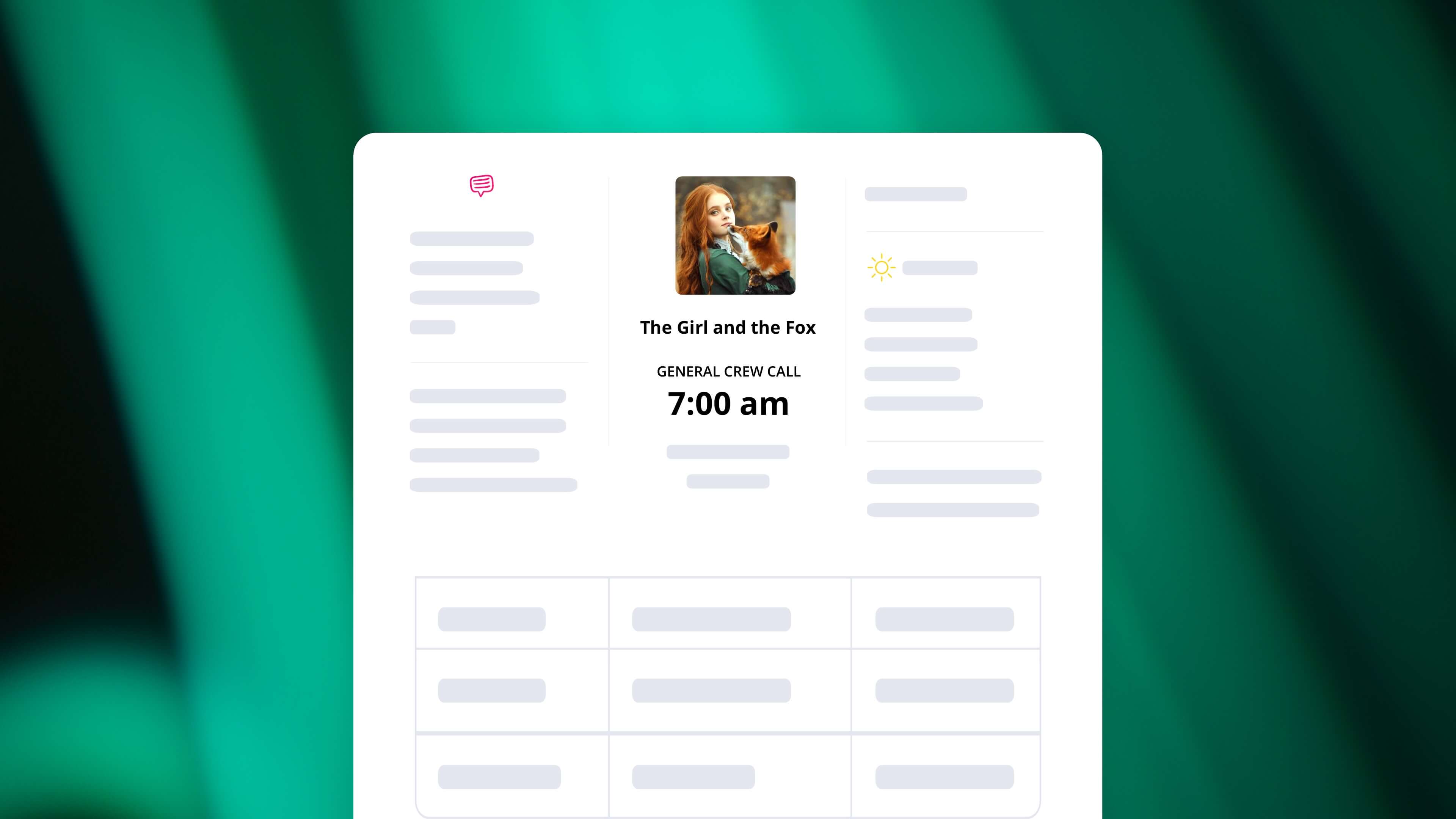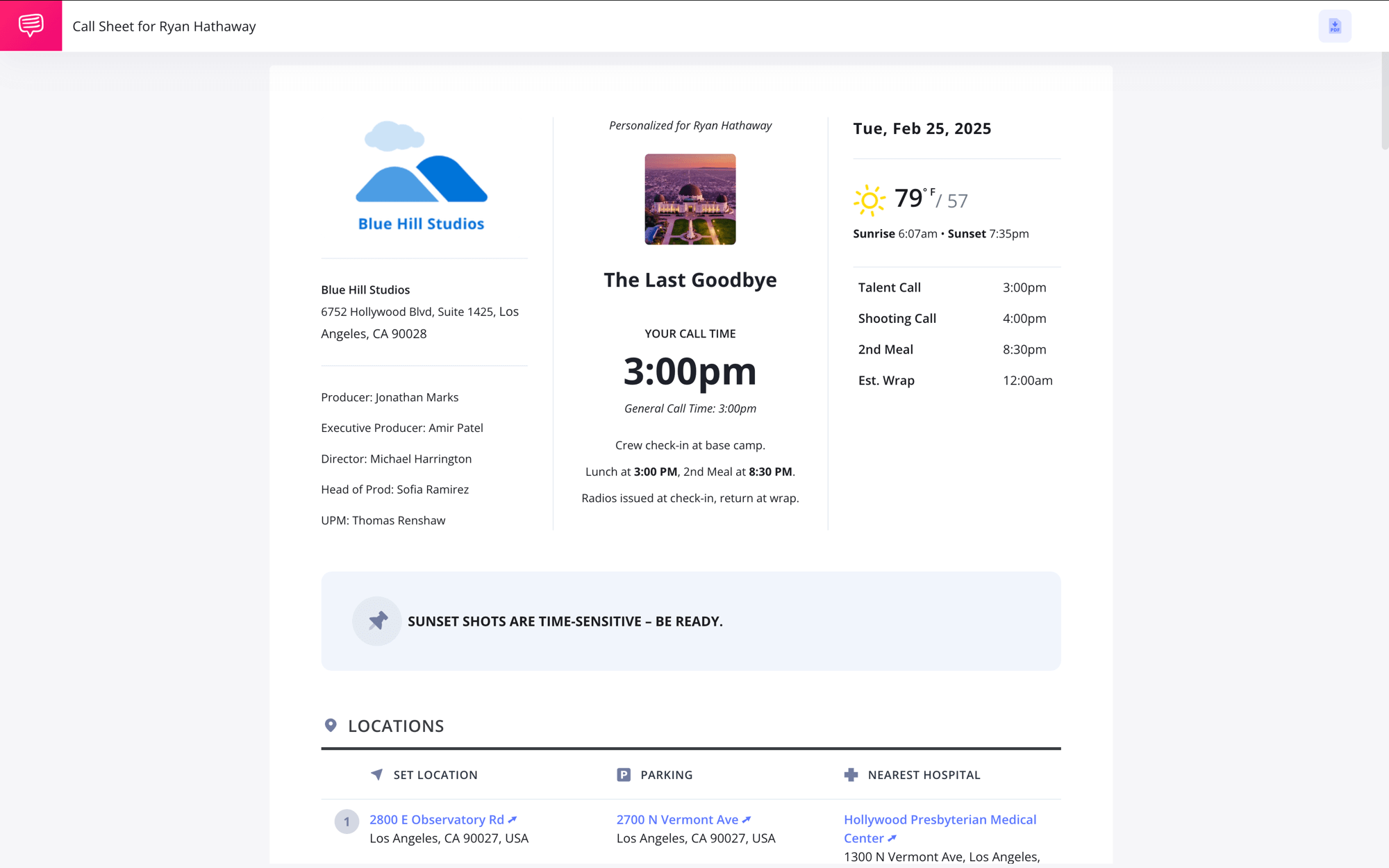A call sheet is the backbone of any film, TV, or photo production, providing the critical details everyone needs to stay organized. But for newcomers, the jargon on a call sheet can be confusing. This guide breaks down common call sheet terminology, ensuring you navigate one with confidence.
How to Create a Call Sheet & Add Contacts to a Project
Call Sheet Terminology Explained
What is a call sheet?
A call sheet is a crucial document in film and television production that serves as a daily schedule for the cast and crew. If you’re new to the industry, you might wonder what is a call sheet, and why it is so important. Simply put, it ensures that everyone on set knows exactly where they need to be and when.
Typically prepared by the first assistant director or production team, it includes essential details such as call times, shooting locations, weather forecasts, scene breakdowns, and contact information. By outlining the day’s schedule and responsibilities, the call sheet ensures that everyone on set is informed and prepared, helping the production stay on track.
Beyond just scheduling, a well-structured call sheet helps minimize confusion and delays by clearly listing key crew positions, transportation details, and any special instructions for the day. It acts as a reference point for the entire team, ensuring smooth communication and coordination. Whether on a small independent film or a major studio production, the call sheet plays a vital role in keeping the workflow organized and efficient.
Call sheets are adaptable documents, tailored to fit the unique demands of different types of productions. Understanding what is a call sheet in various production environments helps crew members adapt quickly and work efficiently. While the core elements remain consistent, specific industries may include additional details to address their particular workflows and priorities.
Adapting Call Sheet Format for Different Productions
Customizing a call sheet
Call sheets vary by production type, ensuring smooth coordination. Films include coverage notes, commercials prioritize client approvals, music videos feature stylized shot lists, and live productions detail broadcast schedules.
While most call sheets follow a standard call sheet format, different types of productions may include unique elements:
- Film & TV: Includes coverage notes, AD breakdowns, and DOOD reports.
- Commercial Shoots: May prioritize client approvals, agency reps, and brand guidelines.
- Music Videos: Often feature more stylized shot lists and frequent location changes.
- Live Productions: Call sheets may include broadcast schedules and crew shifts.
In film and TV production, where constant changes require precise coordination, software streamlines the process by auto-filling key details, reducing errors, and enabling real-time updates. Smart templates and built-in industry terminology ensure every call sheet is clear, accurate, and production-ready. Check out the example below to see how StudioBinder’s Call Sheet Generator structures call sheets and decodes industry jargon.
Click the image link below to explore the full call sheet and see its features in action.
Created in StudioBinder's Call Sheet Builder
As you review the call sheet, you’ll notice various industry terms and key elements essential for smooth production coordination. In the next section, we’ll break these down to help you understand their function and importance.
Production call sheets are vital documents in film production, keeping the entire cast and crew aligned on the shooting schedule, locations, and logistics for a shoot day. Understanding call sheet terminology ensures that every crew member knows exactly where they need to be and what’s expected of them on set that day.
Below is a detailed call sheet glossary covering crew calls, scene numbers, specific call times, and other film set terminology & slang—helping you read a call sheet like a pro.
Related Posts
Understanding Essential Information
Header information on a call sheet
The header serves as a foundation, providing key information at a glance. Call sheets include critical details such as production contacts, weather forecasts, and scheduling notes, ensuring the entire crew stays aligned throughout the day. This section ensures that every cast and crew member starts the day with a clear understanding of the production’s basic details.
From the project title and shoot date to weather conditions and natural lighting cues, these elements help the team anticipate logistical needs and potential challenges. Since each production relies on precise scheduling, knowing what is a call sheet ensures smoother coordination among departments.
Whether it’s planning around sunrise and sunset for optimal lighting or preparing for weather-related adjustments, the header information keeps the production on track and informed.
Key elements of the call sheet header include:
- Production Company and Contacts: This lists the name of the production company and key contacts for quick reference.
- Production Title and Date: Clearly states the project’s name and the specific shoot date.
- DOOD (Day Out of Days): A chart used in call sheet templates to track when each actor is working, holding, or finished throughout the production schedule.
- Weather Forecast and Sunrise/Sunset Times: Provides real-time weather updates and natural lighting information to assist in planning.
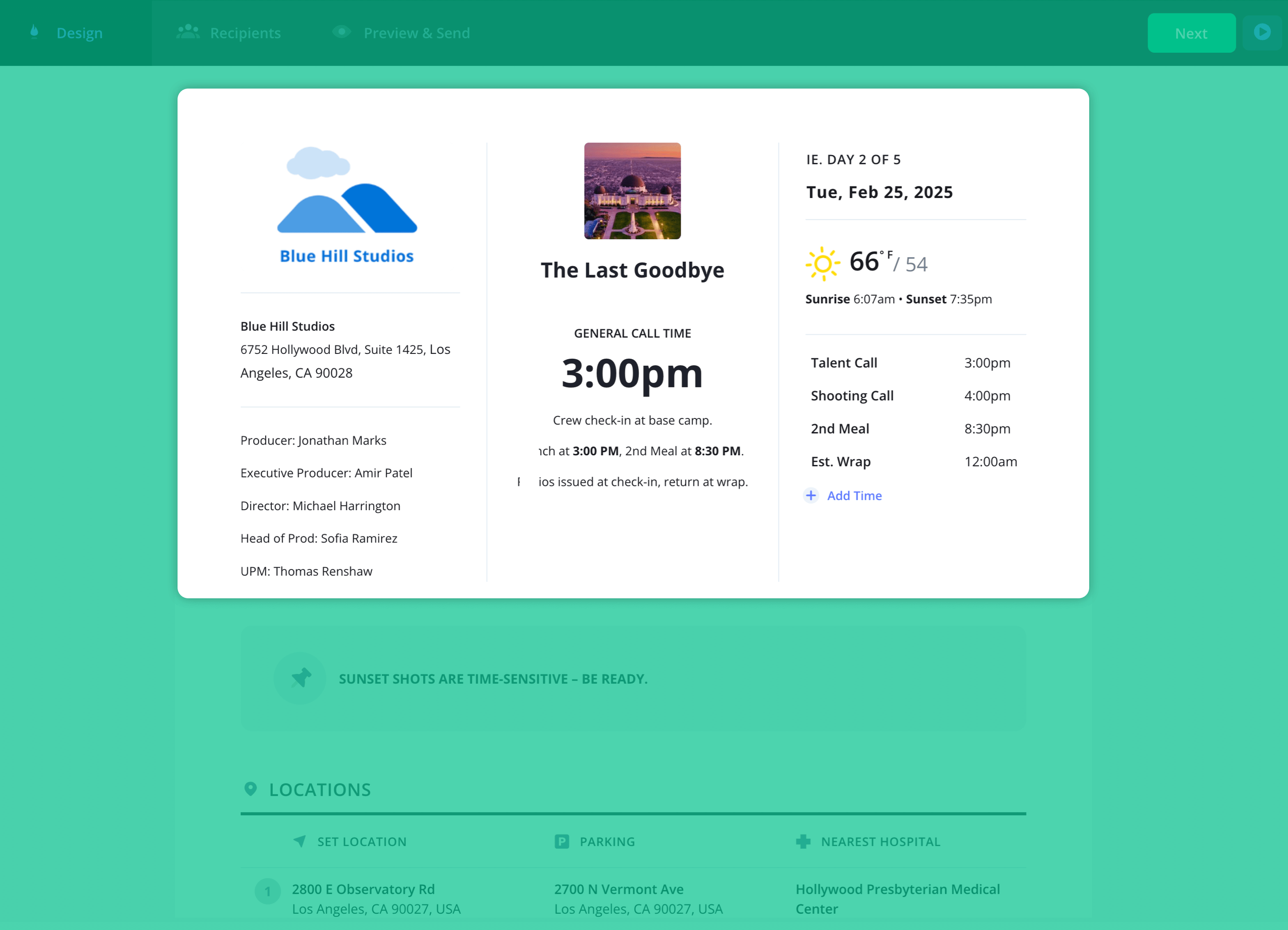
Call sheet header created in StudioBinder’s Call Sheet Generator
While the header of a call sheet lays the groundwork with vital production details, the next crucial element is location planning. Knowing where to be—and how to get there—ensures that the day runs smoothly, minimizing confusion and delays.
Now, let’s break down how call sheets organize location information to keep productions running seamlessly.
A Guide for Filmmakers
Locations on a call sheet
Clear and organized location management is crucial for maintaining a smooth production day. Before the shoot, a location scout has already visited the site and made a plan. The call sheet provides detailed information about shooting locations and parking logistics, ensuring that cast and crew can arrive on time and prepared. By streamlining navigation and accessibility, productions can minimize delays and keep the schedule running efficiently.
Here are some examples of important location information:
- Shooting Locations: The call sheet includes precise addresses for each filming location, often with map links.
- Parking Instructions: Specific directions and guidelines for where cast and crew should park.
- Nearest Hospital: Emergency contact details for the closest medical facility to ensure on-set safety.
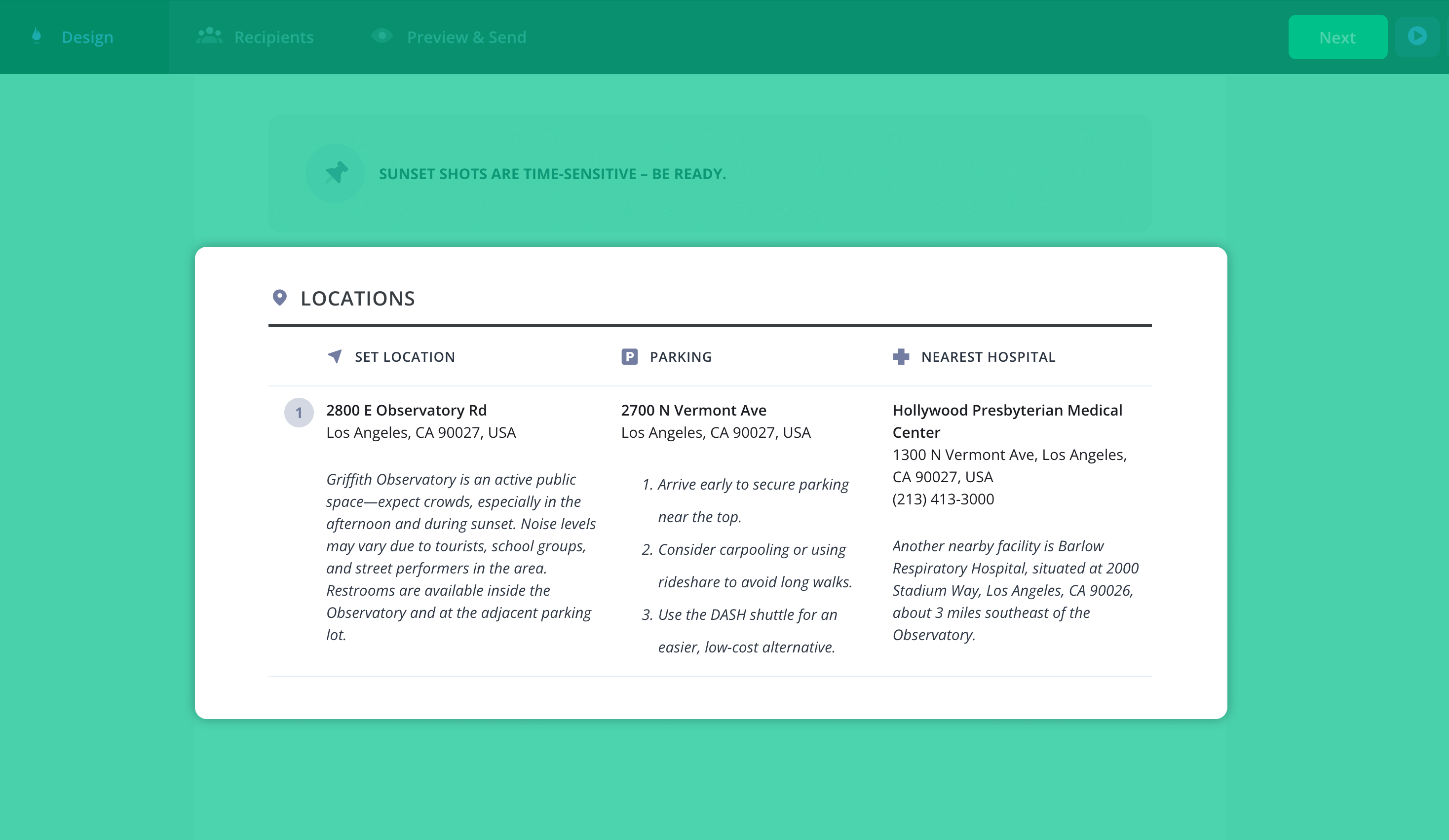
Master locations with StudioBinder’s Call Sheet Generator
Once cast and crew know where they need to be, the next crucial piece of information is when they need to be there. A well-structured call sheet not only provides detailed location logistics but also outlines precise scheduling to keep the production running efficiently.
Now, let’s break down the essential scheduling details found in a call sheet.
Related Posts
What is a Call Time?
Understanding film set scheduling
Call times are driven by the shooting schedule and dictate the start of the day for each team member, ensuring a coordinated workflow from the first shot to the final wrap. But what is a call time exactly? It refers to the specific moment each individual is expected to report to set, which is carefully scheduled to prevent downtime and maximize efficiency.
Understanding these scheduled times—along with key production terms like crew calls, meal breaks, and company moves—helps everyone stay on track and anticipate the day’s rhythm.
Here are the key terms to understand film scheduling:
- Call Time: A call time (film production) refers to the exact time a crew member or actor is required to be on set that day.
- Crew Calls: The scheduled time when most of the crew is expected to arrive on set.
- First Shot: The planned time for the first take of the day, based on the shot list and film call sheets.
- Breakfast/Lunch: Scheduled meal breaks, often noted as “LUNCH IS 6 HOURS AFTER CALL,” per union guidelines.
- Wrap Time: The estimated time when production will conclude for the day.
- Company Move: Also known as a load in & load out, this is a relocation from one shooting location to another within the same shoot day.
- D/N (Day/Night): Specifies whether a scene will be shot during the day or at night, helping with film call sheets and planning.
- Pages & Eighths: Script pages are divided into eighths as a rough way to estimate scene length and gauge how many pages will be shot in a day.

Shooting schedule created in StudioBinder’s Call Sheet Generator
Call times keep the production running smoothly, ensuring everyone is where they need to be. If you’re new to production, you might ask, what is a call time, and why is it crucial? It’s the scheduled moment each person must be on set, allowing for precise coordination between departments. With the day’s timeline set, the next step is managing cast schedules for seamless coordination. Now, let’s look at the key terms used to manage talent scheduling effectively.
Film Call Sheets and Talent Scheduling
How actors’ schedules are managed
Effective talent scheduling is essential for keeping a production on track and ensuring a seamless workflow. Call sheets serve as the central tool for organizing actors’ schedules, providing clear directives on arrival times, on-set requirements, and overall availability. This is why knowing what is a call sheet should be one of the first things any new crew member should learn—it serves as the roadmap for the entire production.
From tracking key status updates to coordinating transportation and preparation times, a well-structured system ensures that every cast member is where they need to be when they need to be there.
- SWHF (Start Work/Work Finish): An important notation on a SWHF call sheet, indicating whether an actor is starting, finishing, or holding on set that day.
- Cast ID: Each actor is assigned an ID number for quick reference on the film call sheet (e.g., “#1” is the lead actor).
- PU (Pickup Time): The time when production-arranged transportation will pick up an actor from their hotel or home.
- H/MU (Hair & Makeup Time): The assigned time an actor must be in the makeup chair before filming.
- H/H (Hold & Hold): A status used on film production call sheets when an actor is on standby but not immediately needed.
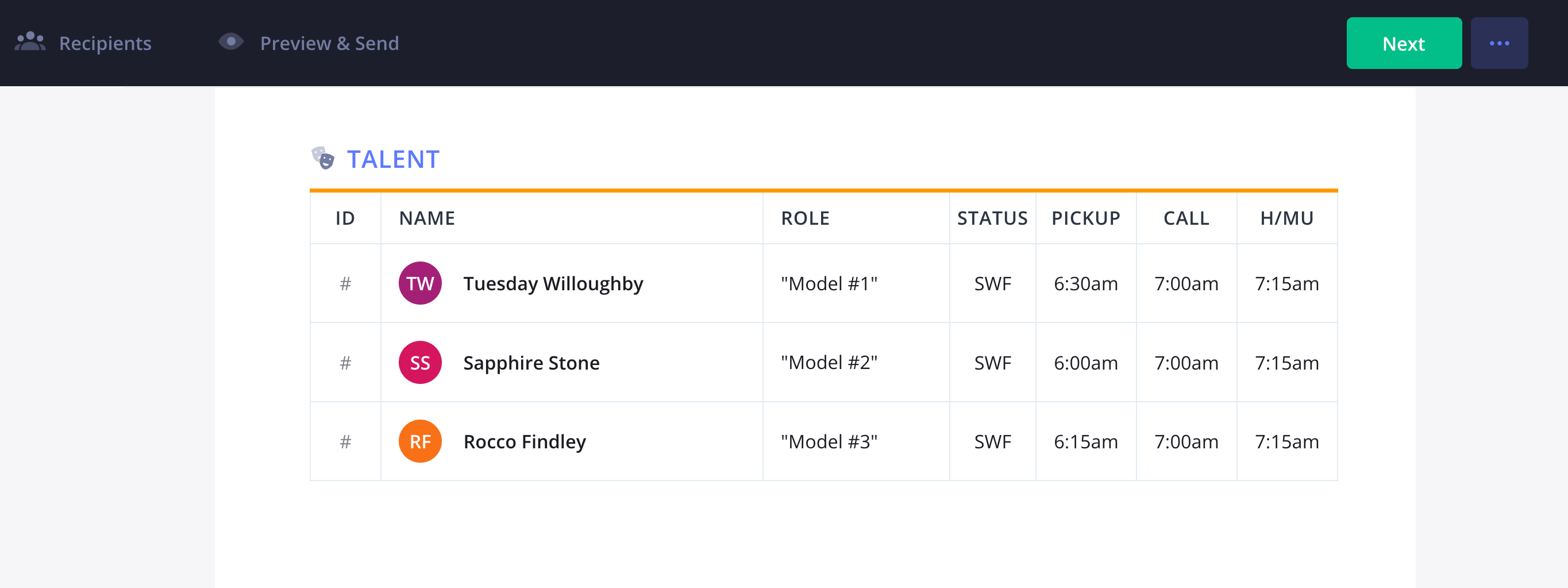
Talent schedule created with StudioBinder’s Call Sheet Generator
A well-organized call sheet ensures that every actor arrives on time, ready for their scenes. By tracking call times, transportation, and preparation schedules, productions can minimize delays and keep the workflow efficient.
But actors aren’t the only ones with carefully planned schedules. The call sheet also lists the entire crew, ensuring each department knows its role and responsibilities. Let’s break down the key crew positions and their functions on set.
Call Sheet Crew Roles
Deciphering film crew positions
A well-structured crew breakdown is essential for maintaining organization and efficiency on set. A clear crew list helps streamline communication, coordinate responsibilities, and ensure each department stays aligned, keeping the production running smoothly.
- Director (DIR): The lead creative person responsible for the overall film production and storytelling.
- Producer: Oversees logistics, budgeting, and coordination across departments.
- Director of Photography (DP): Leads the camera crew, ensuring visual composition and lighting are on point.
- Gaffer: Head of the lighting department, working closely with the DP to achieve the desired mood.
- Key Grip: Manages grip and rigging, handling camera movement, and support equipment.
- 1st AD (First Assistant Director): Runs on-set operations and ensures the shooting schedule is followed.
- 2nd AD (Second Assistant Director): Handles cast logistics, call sheets, and crew calls, ensuring all talent arrives at specific call times.
- Line Producer: Oversees budget and logistics for the production, ensuring all resources are allocated efficiently.
- Script Supervisor: Tracks scene continuity, dialogue accuracy, and script notes during shooting.
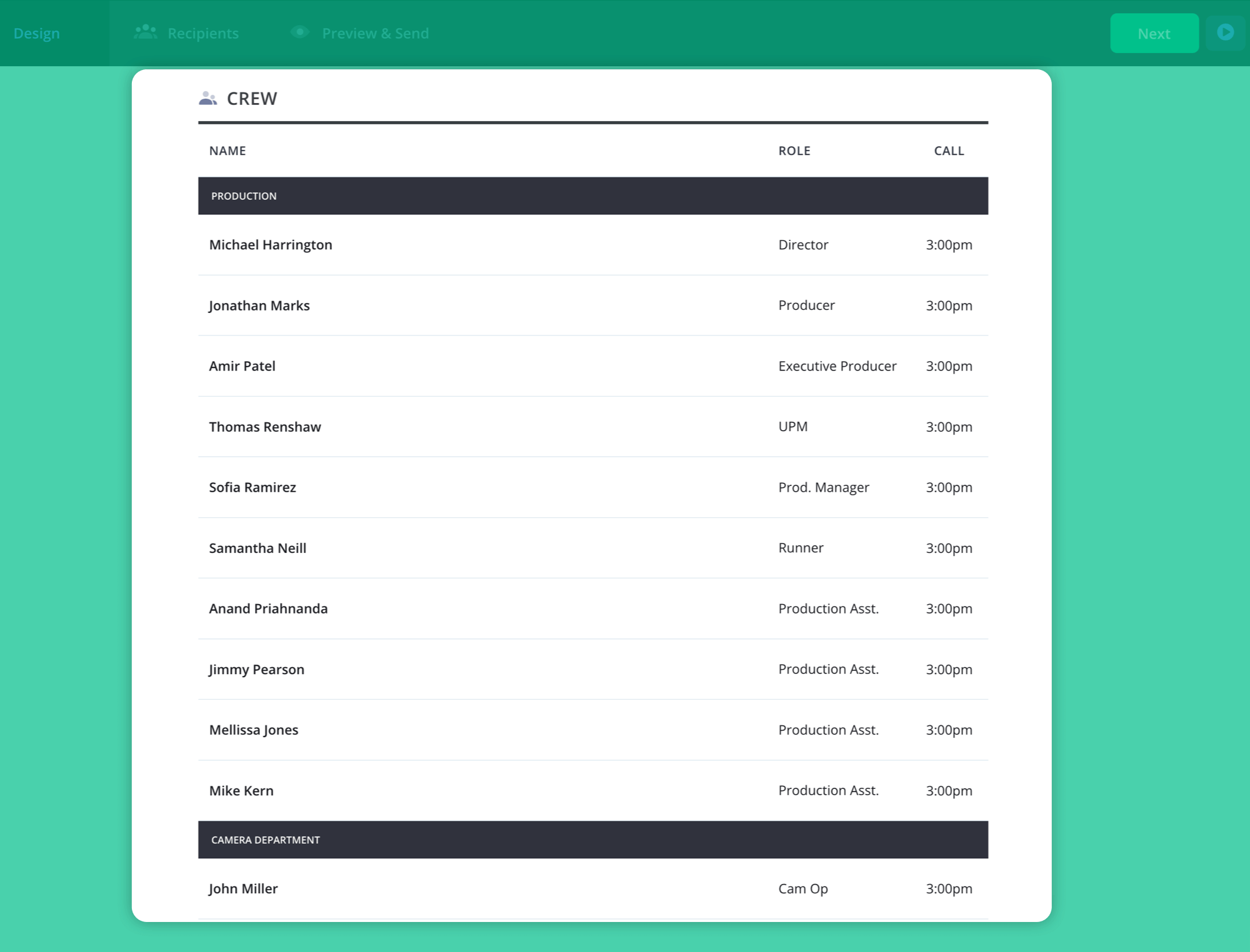
Crew call created in StudioBinder’s Call Sheet Generator
With clear communication and coordination, the team can work efficiently to bring the director’s vision to life.
Beyond listing crew positions, a call sheet also includes department-specific notes to address key updates, equipment needs, and special instructions. Let’s explore how these notes help each team stay aligned and prepared throughout the shoot.
Let’s take a look.
Department Notes on a Call Sheet
Keeping every team aligned
A well-organized call sheet ensures that every department has the information needed to operate efficiently. Department notes provide tailored instructions for teams such as camera department, sound, wardrobe, prop master, and art department, helping to prevent confusion and delays.
What Are Department Notes?
Department notes highlight key updates, equipment needs, and changes relevant to specific production teams. These notes enable directors, producers, and assistant directors (ADs) to communicate crucial information throughout pre-production and on-set operations.
- Crew Notes: Specific instructions or reminders for individual departments, such as camera, lighting, or wardrobe.
- Tech Specs: Details on required equipment, camera settings, or sound configurations.
- Set Dressing Notes: Instructions for the art department regarding scene setup.
- Wardrobe Notes: Guidelines for costume changes, fittings, or continuity details.
- Prop Requirements: A list of necessary props for specific scenes, including any last-minute changes.
- Makeup & Hair Notes: Special styling or makeup effects required for the day’s shoot.
- SFX Coordination: Information on special effects, stunts, or VFX integration.
- Weather Contingency: Backup plans in case of weather-related schedule changes.
- Load-In & Strike Times: Scheduling for when departments need to set up and break down equipment or sets.
- Sound Requirements: Notes on mic placement, background noise considerations, or ADR (Automated Dialogue Replacement) needs.
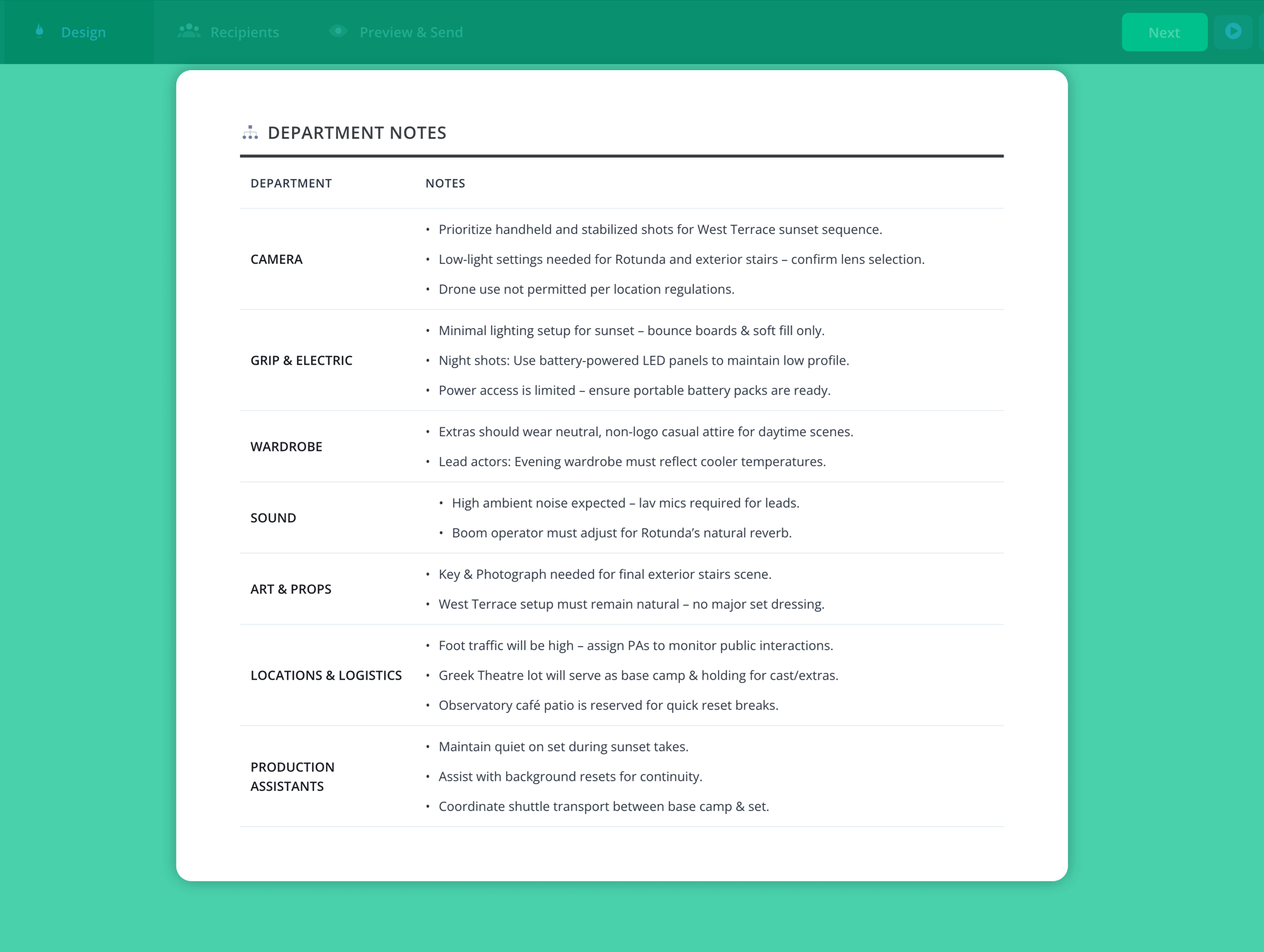
Department notes created in StudioBinder’s Call Sheet Generator
Department notes ensure that every team has the details they need to operate efficiently, preventing miscommunication and production delays. By outlining key instructions and contingency plans, the call sheet keeps the entire crew aligned and ready for the day’s shoot.
With each department prepared, the final step is mastering the overall call sheet format—understanding how all these elements come together to keep production running smoothly.
Related Posts
Call Sheet Terminology
Final thoughts
Mastering call sheet terminology is key to running an efficient and well-coordinated film set. A properly structured call sheet keeps everyone on the same page, from call times and crew roles to location logistics and shooting schedules. Whether you’re a producer, assistant director, or crew member, understanding these details ensures smooth communication and prevents costly delays. Keep this guide handy as a quick reference, and you’ll be able to navigate any call sheet with confidence, making every production day more seamless and productive.
UP NEXT
Dive deeper into call sheet creation
Understanding call sheet terminology is just the first step. To truly master call sheets, it’s important to see how they’re structured, formatted, and used in real-world productions.
- Learn best practices for creating clear, efficient call sheets
- Avoid common mistakes that slow down production
- See real-world examples of professional call sheets in action
